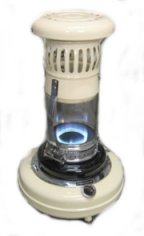(This page is a work in progress and the subjects are not in
any specific order.)
1.
Preparing lamps for storage
Question: I have a lamp that I
will not be using anymore and would like to know how to "decommission" it . I
want to display but not use it. My main concern is kerosene drying out on the
wick and reservoir.
Answer: Empty all fuel from the tank. Set the wick to be about 1/16''
above the wick tubes and light it, then replace the chimney. The fuel in the
wick will burn off, then the wick will burn down level with the wick tubes.
Pour a little almost pure alcohol in the tank and swish it around to absorb
any moisture caused by condensation, then pour it out. Wipe all male threads
with a cloth and female threads with a Q-Tip saturated in alcohol to remove
any fuel residue. With a Q-Tip, apply some liquid automotive polish to the
threads, then wipe off the polish. The lamp will then be completely dry and
preserved until it is needed again, and the fill cap and burner will not be
glued tight with old fuel residue.
2. Will a 12'' tall chimney on a center draft lamp burn better than a
10'' chimney?
Question: I have a quick
question concerning your 2 5/8 center draft chimneys. I plan on ordering one
very soon. Does it make any difference if I get the 10 inch or 12 inch
version? I am not at high altitude, but I seem to think that a taller chimney
burns cleaner and creates better air flow. What is your recommendation?
thanks, -Steve
Answer: The 10''
height chimney burns perfectly at lower altitude. The two chimneys are not
identically shaped except for the height. The 10'' has a slightly larger
diameter bulge and throat that equates to virtually the same airflow through
the chimney at normal atmospheric pressure.
The 12'' is required for ball shades and very high altitude. The atmospheric
pressure at 6,000 feet elevation equals about 25'' and the 12'' chimney with a
smaller bulge helps direct the less oxygen-rich airflow around the flame
spreader for better combustion and therefore a clean burn with excellent light
output.
3. How
do you get a P&A Royal to burn with a smooth flame?
Question: I tried
the pre-burn eyedropper twice and burned it dry once. And trimmed and trimmed
and trimmed. It still can't match the output of the Rayo I have. Fuel is Klean-Heat.
Is it the thicker wick and they just don't burn as well as the thinner Rayo? -
Greg
Answer: A thick wick often
has to be burned level 3 times. After the 2nd dry burn, remove the flame
spreader and raise the wick 1/4''. Look at the outside edge of that wick and
often you will find there is an unburned fringe all around the outside. Trim
off that fringe and then burn dry again. After that it should burn perfectly.
The thick wick on a P&A Royal is not designed to have more output than a Rayo
- a full curl flame is a full curl flame, the wicks are the same diameter and
those two lamps use the same chimney. The design concept is for more capillary
fibers (thicker wick) to produce the same flame height as other #2 lamps with
less wick exposed. That means no fuel starvation at the top of the wick and
thus the wicks last at least twice as long. The only problem is in the initial
leveling of the thicker wick.
4.
Lamp draft tube off-center, flame spreader dented
Question: Hi,
I recently got a "TIny Miller" finger lamp that has a dented flame spreader.
It burns higher on the side with with dent (although I burns higher further
around the wick than the dent goes), is i possible to bend the draft tube just
a bit toward the high flame to compensate?
Answer: You can gently bend the draft tube to make sure it is centered within
the outer tube. It is better to straighten the dent in the flame spreader.
Tiny Miller flame spreaders don't have a Liverpool Button and are generally
just straight thimbles. Insert a dowel into the flame spreader and roll it
across a flat, hard surface to gently roll out the dent. If the top is dented
down, push it up with a dowel, going gently at all times.
Response. HI, the info about straighting the Tiny Miller
flame spreader worked great.
5. I have a question. Although
the Rochester lamp makes a great table lamp, it was made to hang in shops.
It gets so
hot that it makes me nervous.
Answer: Your Rochester store lamp was actually made into
a heater, the cabinet designed to cut down the light output. It does indeed
produce over 10,000 BTU/hr of heat.
The wire hangers do get hot and the smoke bell gets very hot indeed. I
have them myself.
http://www.milesstair.com/B_&_H_lamps.html#HANGING
When store lamps were marketed they were indeed marketed to small stores,
the late 19th Century corner stores so common then. By 1900 over 10 million
store lamps had been sold. Ceilings were higher than today and the smoke
bells were wide and cast iron for absorbing and dissipating the heat. The
concept for the ''store lamp'' was both heat and light, the small shops not
having a heat source, so the lamp was generally hung over the sales counter.
The heat is not sufficient to weaken the wire or cable supports, though.
The market for store lamps was from Pennsylvania up through the New
England states, cold in the winter and having the greatest concentration of
population living in cities without modern transportation, the corner stores
providing the essential needs of the people. The advent of readily available
electricity before WW I killed off sales of store lamps.
Stands for store lamps were available to enable them to be used as table
lamps. Those stands are quite rare today. I made my own on a wood lathe.
http://www.milesstair.com/Lamp-repair.html
6. The wick in my Rochester #2 size
lamp will not move easily. Is the wick too thick? I do not have
the original ''band'' to attach the wick to the wick sleeve. Can I use
wire? Why does the flame spreader fit over the draft tube instead of
inside like a Miller?
Answer: Miller made Rochester lamps until 1892 and
used the same wick raiser system on early Miller-brand lamps. Miller-made
''Baby Rochester'' lamps were very odd and rare, very few sold in 1890-91, so
they did not bother with the corrugated attachment system and used a copper
wire. I have a photo taken of the original wick with wire fastener in one of
my Baby Rochester lamps >
http://milesstair.com/Lamp_Wick_photos/Baby_Rochester-1.jpg
Rochester purchased the first thimble flame spreader patent (Hinkle, Jan.
1884) and therefore got in first with an over-the-tube flame spreader patent.
Everyone else, including Miller, had to use an inside-the-tube flame
spreader. Both styles work but the over-the-tube has the theoretical
advantage of not leaking fuel down the center draft tube if the lamp is stored
with fuel in the font and the wick raised above the height of the draft tube.
One problem you should be aware of is the wick sleeve on an early Miller and
most Rochester lamps is that the sleeve was cut from copper tubing. If you
have used a tubing cutter you know that they cut from the outside and
therefore slightly indent the cut into the inside of the tube. And the edge
is sharp. That sharp edge can cut into the draft tube when raising the wick
because the lift rod is attached only at the bottom on one side, hence the
wick sleeve absolutely must have the inclination to ''cant'' in the opposite
direction at the top and dig into the central draft tube. My Miller Dresden
was a perfect example of that effect and the wick was extremely difficult to
move. I have the fix shown here >
http://milesstair.com/Beginning_Lamp_Restoration.html#CLEANING

 . .
. .